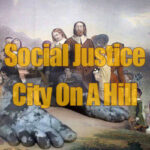Part Two / Tres Dias:
About Tres Dias
Tres Dias seems to be another […] device developed to support the Catholic Church’s ecumenical activities. […]“Holy language” notwithstanding; it is unbiblical and, therefore, draws the gullible and easily bamboozled away from sound biblical doctrine and toward the heretical teachings of the Roman cult.
What is it about Tres Dias that brings into question its claim to be a Christian movement? To begin with, it appears to be an iteration of Catholicism’s Cursillo movement dressed up in ecumenical clothes. A religious movement with that pedigree surely must be carefully examined.
The TRES DIAS Movement endeavors to bring Christians to a closer, more personal walk with their Lord Jesus Christ and encourage them to Christian leadership and Apostolic Action in their environments. TRES DIAS is based on the principles, the method, and the teachings of the Roman Catholic Cursillo movement initially proposed by Bishop Juan Hervas, Eduardo Bonnin and their fellow Christians. —Essentials, United Tres Dias home page
How close are the ties between Tres Dias and the Catholic Church? They are very close:
Tres Dias is the Protestant counter-part of the Catholic Cursillo movement. However, many Catholics are active in both organizations, and this also assists in the breaking down of denominational walls as Christians find they can share in those areas that bind us together in Christ, while downplaying areas of disagreement! Open communion is practiced, and anyone who acknowledges Jesus Christ as Lord is welcome to partake. — West Point Post Chapel
Still not convinced that Tres Dias is little more than a Catholic wolf in sheep’s clothing? Consider that the Mid-Hudson chapter of Tres Dias Held its retreats in a Catholic monastery for a period of 32 years.
From the very first weekend in November, 1972 through June, 2001, the Mid-Hudson Chapter of Tres Dias held the retreats at the Oblate House (a Catholic Monastery) in Balmville, NY, just a bit north of Newburgh. We are currently holding them at the Graymoor facility in Garrison, NY while we look for a more permanent home. – Ibid.
Some might wonder what the Graymoor facility is. That’s easy. Graymoor is:
The home of the Franciscan Sisters and Friars of the Atonement–Graymoor home page
How Catholic is Tres Dias? The movement’s web sites freely acknowledge that Tres Dias has its roots in Catholicism’s Cursillo movement and conforms to the formats and guidelines of groups such as Cursillo. Knowing this led me to learn just how much Catholic heresy is involved in Cursillo, the wellspring from which other off-the-wall movements sprang from:
The Cursillo Movement began on the Mallorca Island, we could say “at the foot of the Shrine of Our Lady of Luc”. All of its the reflections, consultations and reunions have always been entrusted to the care and custody of Our Lady. Bishop Juan Hervas, one of the founders of the Movement, formulated it in this way: “The Cursillo Movement was born in the womb of the Virgin Mary. Our gaze has always been directed towards her, and so the Movement spread serenely beneath her protection. From its birth to our times, Mary has always had an important role in the life of the Movement and in the life of its individual members. She is always present in the Cursillo.–Frances Ruppert, [Cursillo World President] Mary in the Cursillo Movement
Whoa! It appears that Cursillo is a Marian movement. Since Tres Dias grew out of and claims conformance with, Cursillo I would argue that Tres Dias also is a Marian movement disguised as a Christian organization.
What have we got so far? Tres Dias appears to be nothing more than Catholicism’s Cursillo movement dressed up in Christian trappings. I learned that Tres Dias actively recruits new adherents, which must be introduced to the group by a mature member and only permits admission to the body following a period of preparation/conditioning. I learned that Tres Dias conducts gender specific gatherings and does not permit husbands and wives to attend together. To ease any difficulties that may arise due to one spouse being out of the home for a long weekend, Tres Dias provides a ‘helper’ to provide those services that the missing spouse normally would be expected to perform.
I believe that Tres Dias is actively involved in ecumenical activities in support of the Roman cult’s program to gain hegemony over world religion. I believe that, to that end, Tres Dias plays a game that seems very much like brainwashing and thought control.
If Tres Dias conforms to Catholic formats and guidelines, then Tres Dias cannot, by definition, be Christian or biblical.
I am not alone in believing this:
The Cursillo movement is one of the newest of Rome’s successful plans to fool sleepy Protestants and others. The Roman Catholic Church has replaced the mailed fist approach to non-Catholics with the Trojan horse of infiltration by guile, intrigue and deception. The Cursillo Movement is an example. A pamphlet from their Louisville, Kentucky, office says, ‘Although it is Catholic in origin and setting, now Protestants and Catholics can have an encounter with Christ together.’ This retreat revival weekend is called a Cursillo.–Alex Dunlap, Cursillo Movement, quoted in Beware of Cursillo the Cephas Library,
The Cursillo Movement is a program within the Roman Catholic Church to bring “renewal” and work as an instrument of “evangelizing” non-members. The May 20th issue of the Vatican’s L’OSSERVATORE ROMANO reported the pope’s reminder to its participants of the inseparable link between “evangelizing” and submitting to the Roman yoke: “To evangelize means bringing the Good News of Christ ‘into all the strata of humanity’ … But there is no new humanity if there is not first of all new persons renewed by Baptism and by lives lived according to the Gospel. The Cursillo weekend retreats appeal to Catholics and non-Catholics alike so a word of warning must be given to its basic purpose–Catholic evangelization and indoctrination (M.H. Reynolds, Jr., Fundamental Bible Church Bulletin, Los Osos, California, June 2, 1985)
~~~~~~~~~~~~~~~~~~~~~~~~~~~~~~~~~~~~~~~~~~~~~~~~~~~~~~~~~~~~~~~~~~~~~~~~~~~~~~~
Baptist official cautions churches to be wary of renewal weekends
By Todd Starnes
NASHVILLE, Tenn. (BP)–When several members of a Georgia Baptist church were invited to attend a weekend of spiritual renewal, their pastor, Paul Mason, didn’t give it a second thought. After all, “Tres dias” (Spanish for three days) sounded like it was a normal, weekend getaway sponsored by a mainline religious denomination.
But a few months after they returned from the retreat, Mason realized he had a problem on his hands at Central Baptist Church, Douglasville. “When I asked them how the retreat went, they told me it was a secret. They couldn’t talk about what happened during the weekend,” he said.
Mason noticed that couples who had attended the Tres dias retreat were secretly inviting other couples to attend the program. After the church’s Sunday school superintendent went to the retreat, he abruptly resigned his church position without reason. And within six months, Mason said the couples who had initially attended Tres dias completely ostracized themselves from the congregation. The result, Mason said, was a divided church.
Determined to learn all he could about Tres dias, Mason uncovered some unsettling information about a spiritual movement that is raising concern in the Southern Baptist Convention. Tres dias is one of three major spiritual renewal movements that emerged from the Cursillo Movement.
Cursillo is a three-day learning, sharing experience of living in a Christian community or a short course in Christianity. The Cursillo Movement originated in the Roman Catholic Church. However, many of the current Cursillo Movements are run by Protestant denominations. The Three major movements in this country are Tres dias, a charismatic movement with ties to the United Methodist Church; “The Emmaus Walk,” sponsored by the UMC; and the Lutheran-affiliated “Via De Cristo.”
The weekend retreats aren’t just aimed at adults. Many Southern Baptist teenagers have attended the UMC’s youth Cursillo called, “Chrysalis” and that has caused the North American Mission Board to sound a word of caution.
“If Southern Baptist teenagers want a deeper relationship with Christ, a three-day weekend is just a quick fix. These retreats often create more problems for a church than they resolve,” said Tal Davis of NAMB’s interfaith witness team.
Mason agreed. “The Emmaus Walk and Chrysalis were adopted and adapted to fit the Methodist denomination and it works well for them. I make my strongest appeal that Baptist teenagers should receive their spiritual training through Southern Baptist organizations,” he said.
Davis said a number of Southern Baptist churches have contacted his office with stories of problems resulting from the retreats. “It’s very strange. Some church members have done extreme things, selling possessions, becoming secretive. It’s almost like the weekend retreat has become the focus of their spiritual lives.” George Osment, a lay leader at First Baptist Church, Scottsboro, Tenn., said the spiritual intensity is so great that leaders of one Tres dias retreat refused to allow a camper to leave. “This person wanted to go home but they wouldn’t let him. He saw what was going on and wanted to leave,” Osment said. “They formed a circle around him and prayed over him.”
Osment said the secrecy surrounding the retreat has caused division in their congregation. “It’s very sad,” he said. Said Davis: “Anything that involves a measure of secrecy sends up a red flag. There’s no need for anybody in a Christian church to keep anything secret. Everything should be out in the open.” Davis said the Cursillo movement is intent on getting as many people out of the church to attend as possible. “There is an elitist mind-set and that can become divisive. It’s a problem,” he said.
And while Davis stressed that he doesn’t believe the Cursillo movement intentionally tries to undermine the local church pastor, he warned that even some pastors have been blinded by the retreats. “Their focus is no longer on the gospel or evangelism, rather the experiences they’ve had.”
Mason noted that the Cursillo movement does good work. “However,” he said, “There are points at which Cursillo and Southern Baptists clash. Let me stress that before any member of a Southern Baptist church goes to a Cursillo, the pastor needs to go first.”
One area of concern, Mason said, is the potential for participants to manifest charismatic tendencies. All participants are recruited by those already in the movement, and thus it does not appear to be open to everyone, he said.
Jean Johnson Green, the international assistant director for the Walk to Emmaus, said that while the retreat may have some problems, the intentions are pure. “Our purpose and vision is to create Christian pilgrims who can go back and strengthen local congregations,” she said. People attending the retreats are called pilgrims and the retreat locations are called communities. The Walk to Emmaus was created in 1977 as the Upper Room Cursillo. It was licensed with the Roman Catholic Cursillo. In 1982, the United Methodists broke from the Catholics and created a retreat that would steer away from Catholic theology, Green said.
Tres dias was actually a Methodist Cursillo that broke off in the 1980s. And while it is a separate Cursillo, the structure is similar to the Walk to Emmaus.
Green admitted there have been some problems with the retreats — specifically the veil of secrecy. “We are doing everything we can to change that policy,” Green said. “The secrecy is part of the tradition of the Cursillo.
“I suppose people were more trusting back in the early days of the retreats,” she said. “We have moved into the ages of the cults and it [the secrecy] has become problematic for us.” Green stressed there isn’t anyone keeping the participants from revealing what happened on the retreat.
As for the accusations of forcibly keeping participants from leaving, Green said it is not a widespread problem. “Yes, there have been those instances, but I want to stress there are very few. Our motive is if we can just keep them at the retreat, they will be changed,” she said. “Again, this is another tradition that needs to be changed. It was a bad decision on the part of the local Cursillo leadership.”
Davis said it’s important for churches to be alert. “The other side of this is that our churches need to be aware and concerned about the spiritual training of the membership,” he said. Out of 78,000 pilgrims attending 370 Emmaus Walk and Chrysalis retreats annually, Green said only one person has left the weekend retreat.
Green said she was also aware of local church concerns. “We stress to our pilgrims that we aren’t better than anyone else. The world is still the same. Our hearts are different. We encourage the pilgrims to go back to their congregations lovingly,” she said. “There are some people, who are baptized by the Holy Spirit, who think they are on a higher plane. When we find out about this, we immediately contact the community leaders and tell the pilgrim this is inappropriate behavior,” she added.
As for Southern Baptists, Davis said the best method of spiritual renewal is through discipleship. “We have some wonderful materials, from ‘Experiencing God’ to ‘MasterLife,'” Davis said. “A balanced approach to spiritual growth involves discipleship over a period of time, using sound, biblical principles and materials.”
There is more to this than we now know. I promise you that. Stand by– God will show us soon.
This is very new and it is violently dangerous. It carries the marks of the Roman Catholic Opus Dei cult, Promise Keepers, Freemasonry, and Charismania. Methods of all the above are melded into one powerful church destroying cult. Also, I need to hear from a Tres Dias leader who has defected. I want to know who is above all of this thing in terms of Principalities and Powers. I do NOT believe it is some devotional Catholic priest and his feely feely Methodist friends. There has to be layer of power above all this. Please step forward. I will NOT burn you by exposing you as my source.
~~~~~~~~~~~~~~~~~~~~~~~~~~~~~~~~~~~~~~~~~~~~~~~~~~~~~~~~~~~~~~~~~~~~~~~~~
A Critique Of Tres Dias
Author: Paul Powell
Source: https://sites.google.com/site/pwcjpowell/cursillo
Let me apologize before I start out because I know that Cursillo is near and dear to the heart of many who have ‘made’ it. While I do not wish to discount the good that can come out of it, I do want to highlight my (and others) concerns about it. I am in a bit of a catch 22 as I am not able to evaluate Cursillo from the inside. In order to ‘make’ a Cursillo I would need to promise not to discuss its inner workings. I have done the best I could to learn about Cursillo from those who have made a Cursillo and are willing to talk about it openly. The rest of the information I have is derived from documents freely available on the web, many of them published for use in Cursillo training.
I’ve heard about Cursillo on and off for some time. I didn’t really think twice about it unless someone asked me to attend and then told me they could not tell me what went on. I found that odd and it turned me off. A friend of mine who had attended a Cursillo weekend said that I should go. I started to do some research on the web and found a lot of favorable and some unfavorable information about it. I began to hear Cursillo group speak at my local Bible Study and realized that I was in the minority that night and that a Cursillo sub-culture existed, of which I could not in good conscience participate. This disturbed me and I continued my research knowing that I was violating the Cursillo motto of “Don’t evaluate, just participate.” Having been in a cult for 6 years at one point in my life and knowing the place secrecy plays in attraction to the group and other group dynamics used in cults I felt uncomfortable with what I found about the ‘Cursillo Method’.
I’ve came across a book (CURSILLO: Little Courses in Catharsis A Critique of the Cursillo and Related Movements), published in 2010, which describes Cursillo and its methods by a Pastor who had attended Cursillo and held many similar weekend renewals. I ordered the book and read it. I contacted the author and he sent me three short magazine articles he wrote (you can read them on his website) that summarize some of his main points. Here is the author’s website which has his email address: http://questioningcursillo.com/index.html The book came out of the author’s Doctor of Ministry dissertation on the long-term effects of the Dutch Reformed Cursillo in Northwest Iowa. The book is very well researched and, I think, gracious in tone. The website is well worth reading through.
Surprisingly the author’s main concern is with the Cursillo Method which he shows can be used with a wide variety of belief systems (such as Large Group Awareness Training seminars – LGAT – est, LifeSpring etc.) and not as much with the theological issues such as ’imputed’ verses ‘infused’ Grace for which Cursillo seemed to be designed. (http://www.equip.org/articles/justification ) There also appears to be a bit of a Semipelagian view in Cursillo that Salvation is our choice (with which Cursillo methods can help) and then God assists us in the growth of our faith through His grace. There are a couple of links on his website of other Pastors/people who have attended Cursillo and made their own reports. The book is well worth getting and reading as it describes some of the Cursillo weekend and the surprises or Palancas that no one can talk about. (Palancas – ‘Levers’ in Spanish – to help move the candidate in the desired direction of accepting Cusrillo and its community. These could be surprise notes from family/friends that they are praying and maybe even fasting for you, small gifts. etc. There can be one or two former Cursillo attendees at your table that you don’t know about until they get up to give their talks or Rollos. There is also the Closura or ending where you are surprised and welcomed into the Cursillo community by those praying for you and other Cursillistas – Candidates who have ‘made’ a Cursillo).
In discussing the history of Cursillo the author mentions that one of the founders, Eduardo Bonnin, was a psychologist and purposely mixed in social psychology (group dynamics) into the Cursillo Method. (I have subsequently leaned that it is possible Eduardo Bonnin merely had a great interest in psychology and was not actually a psychologist.) Cell phones and watches are taken away to keep the candidate in the now and absorbed in the immediate process. No agenda is given so that the candidates don’t know what to expect next. Activities such as coloring posters help to foster a child-like attitude of openness and acceptance of the process. There are sudden, unexpected swings in mood from somber to upbeat that disorient the candidate and help in the reframing and reformation of their mind. The pace of a weekend is fast enough so that there is not a great deal of time to discuss and process what is going on. The peer pressure is subtle, but present and dissent is politely discouraged and ignored. There are 4th day events or re-unions to help new Cursillistas stay active and involved. This was missing from the original design and added later to re-invigorate and help reduce attrition of members. The author also discusses the purpose of Cursillo which is to find strong individuals in various environments and get them trained so they can go back and influence their environments and recruit more candidates. The author has a chapter called “The Unpaid Bills of the Church” where the author reviews some comments by Cursillistas about Cursillo and makes recommendations on what we can learn from Cursillo about strengthening our churches. His chapter on “After the Weekend is Over” gives a good review of the downside of the Cursillo method and the harm it can cause participants.
I did a little research on the Christian Research Institute website and did not find anything directly related to Cursillo, but I did find this article by Hank Hanegraaf discussing counterfeit revivals: http://www.equip.org/articles/the-counterfeit-revival-part-four- Many of the techniques and methods used in counterfeit revivals are the same as described by the above author in his discussion of the Cursillo Method. Part of the history of Cursillo is not to change the format or content too drastically so these links should give you a pretty good idea what might occur at your local Cursillo:
National Cursillo Center, School of Leaders documents: http://www.cursillo.org/leaders/
Cursillo glossary: http://www.cantaelgallo.com/files/Glossary_of_Cursillo_Terms.doc
Progression of Rolls and Meditations: http://www.ftworthcursillo.org/SOL%20Reports/Progression%20of%20the%20Rollos.pdf
Rollos and Meditation Primer: http://www.cantaelgallo.com/files/Rollos/Rollo_and_Meditation_Primer.pdf
I also found this website describing the Group Dynamics used in the Via de Cristo weekend which is the Lutheran version of Cursillo and uses the Cursillo Method: http://www.viadecristo.org/forums/99dynamics.htm In the article the author describes the group dynamics that are used throughout the weekend and how they are carefully orchestrated and escalated to produce what I would describe as a ‘Peek’ or ‘Mountain Top’ experience. The dynamics are used to help ‘move’ the candidate to a commitment to Cursillo and its community. Here is a table from the article which shows the dynamics and how they are used:
PROGRESSION of DYNAMICS on the VIA de CRISTO WEEKEND
| CIRCLES | 18” diameter or the size of one individual | The size of the Rollo Room Table | The size of the Rollo Room | As big as the world in the 4th Day |
| HEARING OUR NAME | Part of our family | Part of Church Family | Part of the Family of God | Called by Jesus Christ |
| SINGING | Thur. Light generic songs | Fri. Songs of Praise to God | Sat. Songs about Jesus | Sun. Spiritual in nature |
| SILENCE | Silent Retreat-get to know yourself | Way of the Cross | Chapel meditations | |
| LITURGY | Fri. Low key | Sat. Builds with community | Sun. Open and expressive | |
| JOKE SESSION | Community builds with laughter | Speaking in front of others | ||
| TALKING | Begins at table discussion | Expands during Decuria | Culminates in Clausura sharing | Sharing of faith with the world |
| TOUCHING | Handshakes | Warm, enthusiastic handshakes | Slap on the back, touch on shoulder | The Abrazzo |
| PRAYER | Private prayers | Praying together as a group | Spoken prayer in Altar Visit | Leading prayers |
NEGATIVE DYNAMICS
| INTIMIDATION | Anything that puts people on the defensive |
| CONFUSION | Appearing unorganized, wasting time, arguments |
| SECRECY | Whispering, giving evasive answers to questions, not being honest |
| BRAGGING | Failing to show humility, lacking a servants heart; in Rollos, discussions, etc. |
| FATIGUE | Skipping breaks, getting candidates to bed too late |
| THEOLOGICAL ERROR | Misquoting the Bible. Making erroneous statements. Example; …when I became a Christian on my Via de Cristo weekend. |
| BORING ROLLOS | Long lectures, failing to focus on outline for this Rollo, complicated sharing, trying to be too clever. |
| OVER-REGIMENTED | Overly controlled, insufficient freedom, giving the impression of ‘brain washing’ |
| FEAR OF CHANGE | Fear that the Team is trying to change them, fear that they will have to change their life, fear that they will have to do something uncomfortable |
| COMPLAINING | Team members complaining about accommodations, meals, etc. |
| EMOTIONALISM | Doing or saying things simply to elicit an emotional response |
| OTHERS? |
OTHERS?
These links will detail some of the concerns about Cursillo and some of the methods it uses:
Maturity Doesn’t Come in Three Days: Cursillo and Evangelical Christians: http://www.ontruth.com/cursillo.html
Manipulating Christians through Group Dynamics part 1: http://www.psychoheresy-aware.org/manipulating1_145.html
Manipulating Christians through Group Dynamics part 2: http://www.psychoheresy-aware.org/manipulating2_146.html
Since Cursillo is originally a Catholic creation, I’ve included a discussion on Ecumenism. I can see an ecumenical effort during a time of crisis or to help the homeless, but not with finding a lowest common denominator when it comes to the tenants of our faith or how to live it. I really have a problem with seeing Jesus attending a Cursillo with the Scribes, Pharisees and Sadducees; after all Jesus was a Jew and why wouldn’t he reach out to his Jewish ‘brothers’? Jesus and Paul were very firm on sound doctrine. Paul even pronounced a curse on those who would teach a doctrine other than that which he delivered to the saints. In His prayer for unity in the church, I don’t believe a case can be made that Jesus was reaching out to the Jewish leaders in an ecumenical manner and there wasn’t a need for ecumenism within His movement at the time as there were no denominations or separate Christian churches. Since the time of His prayer we find ourselves in a situation where we need to carefully evaluate, as did the Bereans of Paul’s message, what is and is not a faithful teaching of God’s word and the Gospel message within ‘Christianity’. (Orthodox Theology , What is Essential Biblical Doctrine?) Jesus came to show us God’s Grace and Truth, I think we need to be respectful and observant of both.
Bible vs. Ecumenism: http://www.wayoflife.org/files/404ab65fbc99c580d5b07b5faed57096-140.html
While I am all for biblical, renewal type weekends, as you can see I am not comfortable with the covert persuasion and other group dynamic methods used in Cursillo. Emotion certainly has a place in our faith, but we are not meant to come to faith through covert emotional manipulation. This type of faith simply won’t last and gives us a false impression of the everyday Christian life. Once the high has worn off then comes discouragement and the attempt to repeat the high. Eventually, through the law of diminishing returns, the participant is left discouraged and disillusioned because the high is gone. I don’t think the methods used are biblical and actually show a distrust or misunderstanding of the simple power of the declaration of God’s word and prayer. It would seem that the Holy Spirit could be completely absent from a Cursillo weekend and the candidate could still have a ‘Peek’ or ‘Mountain Top’ experience which they might confuse for a moving of the Spirit. When I look at how the Gospel was preached and the fruit of the Spirit I don’t see emotionalism, drama or adrenaline highs. I think for these reasons and others it should give us pause and encourage us to re-evaluate the need and use of Cursillo in our churches.
“But we have renounced disgraceful, underhanded ways. We refuse to practice cunning or to tamper with God’s word, but by the open statement of the truth we would commend ourselves to everyone’s conscience in the sight of God.” (2 Cor. 4:2)
Thanks for reading and God Bless!
Email: Paul Powell
* Also known as:
Walk to Emmaus, Via de Cristo, Tres Dias, De Colores, Teens Encounter Christ (TEC), Chrysalis, Kairos, Great Banquet, Dias con Cristo, Celebration, Challenge, Vocare, Tirosh, Chayah, Unidos en Cristo, Chrysalis, Alarga, The Journey, Faith Walk, Vida Nueva, Aventura, Awakening, Camino, Credo Recovery, Diaspora, Discipleship Walk, Footsteps, Happening, Jubilee Journey, Keryx, Koinonia, New Beginnings, Paseo con Cristo, Pilgrimmage, etc.
MORE ON TRES DIAS HERE: PART III








![STARS, WARS, BLOOD & LUST… [The “royal secrets” of the Djedi knights of Scientism]](https://christianobserver.net/wp-content/uploads/2023/11/star-wars-blood-lust-150x150.jpg)

